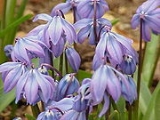
Siberian squill
Encyclopedia
Siberian squill is a bulbous
perennial
, grown for its nodding blue flowers in early spring
. It naturalizes rapidly from seed.
, the Caucasus
, and Turkey
. Despite its name, it is not native to Siberia
.
s have six petal
s and six stamen
s, and are arranged singly or in raceme
s of two or three. Petals may be reflexed to the horizontal when sunlight is bright, but are more often cup-shaped. The flowers are usually blue, but those of Scilla siberica var. alba are white. The stamens of Scilla are separate, unlike those of the related genera Puschkinia
and Chionodoxa
, which are fused into a tube. The pollen
is dark blue.
After flowering, the flower stems become limp as capsules (pods) mature. At maturity, the capsules become purple and split open, releasing small, dark brown seeds. When the seeds are mature, the leaves wither and the plant goes dormant until the next spring.
Seedlings are hollow-leaved.
Bulb
A bulb is a short stem with fleshy leaves or leaf bases. The leaves often function as food storage organs during dormancy.A bulb's leaf bases, known as scales, generally do not support leaves, but contain food reserves to enable the plant to survive adverse conditions. At the center of the bulb is...
perennial
Perennial plant
A perennial plant or simply perennial is a plant that lives for more than two years. The term is often used to differentiate a plant from shorter lived annuals and biennials. The term is sometimes misused by commercial gardeners or horticulturalists to describe only herbaceous perennials...
, grown for its nodding blue flowers in early spring
Spring (season)
Spring is one of the four temperate seasons, the transition period between winter and summer. Spring and "springtime" refer to the season, and broadly to ideas of rebirth, renewal and regrowth. The specific definition of the exact timing of "spring" varies according to local climate, cultures and...
. It naturalizes rapidly from seed.
Distribution
Siberian squill is native to southwestern RussiaRussia
Russia or , officially known as both Russia and the Russian Federation , is a country in northern Eurasia. It is a federal semi-presidential republic, comprising 83 federal subjects...
, the Caucasus
Caucasus
The Caucasus, also Caucas or Caucasia , is a geopolitical region at the border of Europe and Asia, and situated between the Black and the Caspian sea...
, and Turkey
Turkey
Turkey , known officially as the Republic of Turkey , is a Eurasian country located in Western Asia and in East Thrace in Southeastern Europe...
. Despite its name, it is not native to Siberia
Siberia
Siberia is an extensive region constituting almost all of Northern Asia. Comprising the central and eastern portion of the Russian Federation, it was part of the Soviet Union from its beginning, as its predecessor states, the Tsardom of Russia and the Russian Empire, conquered it during the 16th...
.
Description
The flowerFlower
A flower, sometimes known as a bloom or blossom, is the reproductive structure found in flowering plants . The biological function of a flower is to effect reproduction, usually by providing a mechanism for the union of sperm with eggs...
s have six petal
Petal
Petals are modified leaves that surround the reproductive parts of flowers. They often are brightly colored or unusually shaped to attract pollinators. Together, all of the petals of a flower are called a corolla. Petals are usually accompanied by another set of special leaves called sepals lying...
s and six stamen
Stamen
The stamen is the pollen producing reproductive organ of a flower...
s, and are arranged singly or in raceme
Raceme
A raceme is a type of inflorescence that is unbranched and indeterminate and bears pedicellate flowers — flowers having short floral stalks called pedicels — along the axis. In botany, axis means a shoot, in this case one bearing the flowers. In a raceme, the oldest flowers are borne...
s of two or three. Petals may be reflexed to the horizontal when sunlight is bright, but are more often cup-shaped. The flowers are usually blue, but those of Scilla siberica var. alba are white. The stamens of Scilla are separate, unlike those of the related genera Puschkinia
Puschkinia
Puschkinia is a genus of two species of bulbous perennials in the family Asparagaceae, subfamily Scilloideae. It is native to Asia and the Middle East.This genus is named in honor of the Russian botanist Apollo Mussin-Pushkin...
and Chionodoxa
Chionodoxa
Chionodoxa ' is a small genus of bulbous perennials in the family Asparagaceae, subfamily Scilloideae. The genus is endemic to the eastern Mediterranean region, specifically Crete, Cyprus and Turkey. The blue, white or pink flowers appear early in the year making them valuable garden ornamentals...
, which are fused into a tube. The pollen
Pollen
Pollen is a fine to coarse powder containing the microgametophytes of seed plants, which produce the male gametes . Pollen grains have a hard coat that protects the sperm cells during the process of their movement from the stamens to the pistil of flowering plants or from the male cone to the...
is dark blue.
After flowering, the flower stems become limp as capsules (pods) mature. At maturity, the capsules become purple and split open, releasing small, dark brown seeds. When the seeds are mature, the leaves wither and the plant goes dormant until the next spring.
Seedlings are hollow-leaved.

